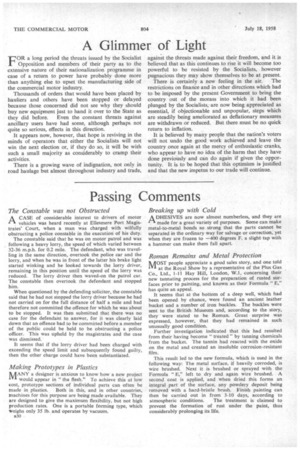Passing Comments
Page 36

Page 37

If you've noticed an error in this article please click here to report it so we can fix it.
The Constable was not Obstructed
A CASE of considerable interest to drivers of motor fk vehicles was heard recently at Ellesmere Port Magistrates' Court, when a man was charged with wilfully obstructing a police constable in the execution of his duty.
The constable said that he was on motor patrol and was following a heavy lorry, the speed of which varied between 32-36 m.p.h. for 0.2 mile. The defendant, who was travelling in the same direction, overtook the police car and the lorry, and when he was in front of the latter his brake light started winking and he looked towards the lorry driver, remaining in this position until the speed of the lorry was reduced. The lorry driver then waved-on the patrol car. The constable then overtook the defendant and stopped him.
When questioned by the defending solicitor, the constable said that he had not stopped the lorry driver because he had not carried on for the full distance of half a mile and had therefore not committed the offence for which he was about to be stopped. It was then submitted that there was no case for the defendant to answer, for it was clearly laid down that an offence had to be committed before a member of the public could be held to be obstructing a police officer. This was upheld by the magistrates and the case was dismissed.
It seems that if the lorry driver had been charged with exceeding the speed limit and subsequently found guilty, then the other charge could have been substantiated.
Making Prototypes in Plastics
AAANY a designer is anxious to know how a new project "I would appear in "the flesh." To achieve this at low cost, prototype sections of individual parts can often be
made in plastics. Both in this, and in other countries, machines for this purpose are being made available. They are designed to give the maximum flexibility, but not high production rates. One is a portable forming type, which weighs only 35 lb. and operates by vacuum.
530
Breaking up with Cold
ADHESIVES are now almost numberless, and they are
made for a great variety of purposes. Some can make metal-to-metal bonds so strong that the parts cannot be separated in the ordinary way for salvage or correction, yet when they are frozen to —400 degrees F. a slight tap with a hammer can make them fall apart.
Roman Remains and Metal Protection
mosT people appreciate a good sales story, and one told "1 at the Royal Show by a representative of the Plus Gas Co., Ltd., 1-11 Hay Hill, London, W.1, concerning their new tannating process for the preparation of rusted surfaces prior to painting, and known as their Formula "E," has quite an appeal.
It seems that at the bottom of a deep well, which had been opened by chance, were found an ancient leather bucket and a number of iron buckles. The buckles were sent to the British Museum and, according to the story, they were stated to be Roman. Great surprise was expressed, however, that they had remained in such unusually good condition.
Further investigation indicated that this had resulted from their having become " treated " by tanning chemicals from the bucket. The tannin had reacted with the oxide on the metal and created an insoluble corrosion-resistant film.
This result led to the new formula, which is used in the following way: The metal surface, if heavily corroded, is wire brushed. Next it is brushed or sprayed with the Formula "E," left to dry and again wire brushed. A second coat is applied, and when dried this forms an integral part of the surface, any powdery deposit being removed with a hard-bristle brush. finish painting can then be carried out in from 3-10 days, according to
atmospheric conditions. The treatment is claimed to prevent the formation of rust under the paint, thus considerably prolonging its life.
Nylon Tubing for Many Purposes
DEVELOPED initially for use in their automatic chassis
lubrication systems by Tecalemit, Ltd., in co-operation with the manufacturers of the raw material/ nylon tubing produced by this company has proved snitable for many applications.
The tubing, which is light in weight—up to 45 lb. can be saved on chassis-lubrication equipment for a passenger vehicle—is made from tough, heat and ultra-violet-light resisting material, and can be used to transmit hydraulic fluid, air, fuel, oils, coolants and many compounds.
Two types of the tubing are manufactured, TTR, which is semi-rigid with a short-time burst pressure up to 2,500 lb. per sq. in., and TTF, which is pliable and can replace most rubber and other flexible piping. The tubing is easy to fit, cutting installation costs by up to 50 per cent, by eliminating the need for any pre-forming.
A comprehensive range of solderless end fittings is available for use with the tubing, special tools and a clamp being provided for fitting them.
A Tine Leyland Film
PRODUCED by Film Workshops for Leyland Motors, , Ltd., a new colour film, shown to the motoring Press recently, is of interest to all concerned with road transport.
Although intended for publicity the film is not cluttered with statistics and includes within its 35 minutes 'running time interviews with Leyland operators both in this country and overseas, sequences showing Leyland vehicles in operation throughout the world, and shots of the Leyland factory and various production processes.
The subjects are linked by a good commentary which never becomes banal, as is so often the case in films Of this type, whilst the Eastmancolour process used for filming hasallowed the' cameramen to produce outstandingly good colour photography, particularly in some Australian views. • The film, called "Wheels of the World," is available in 16 or 35 mm. and can be obtained on free loan from the Publicity Department, Leyland Motors, Ltd., Leyland, Lancs.












































































































